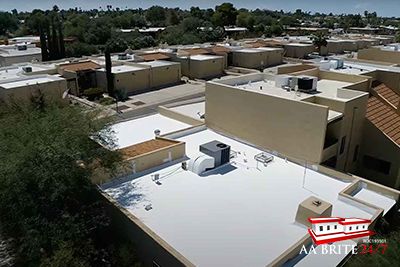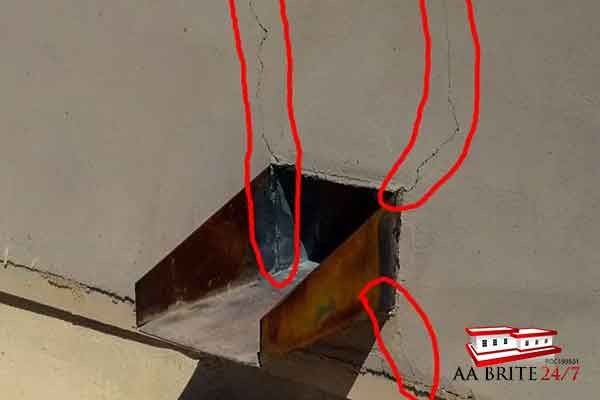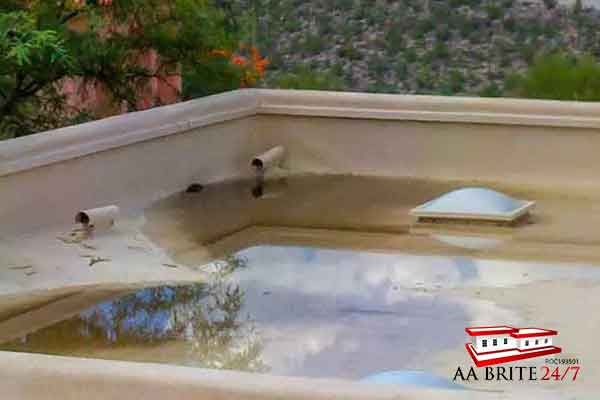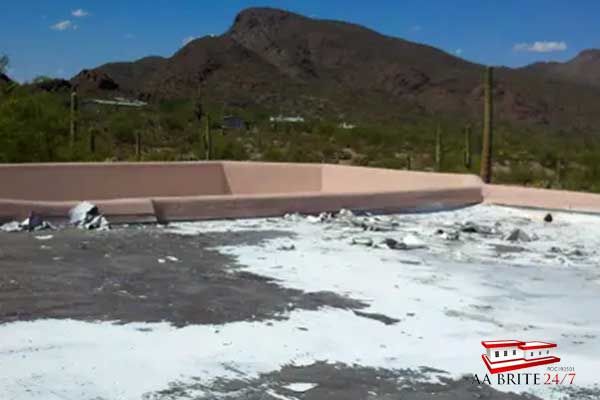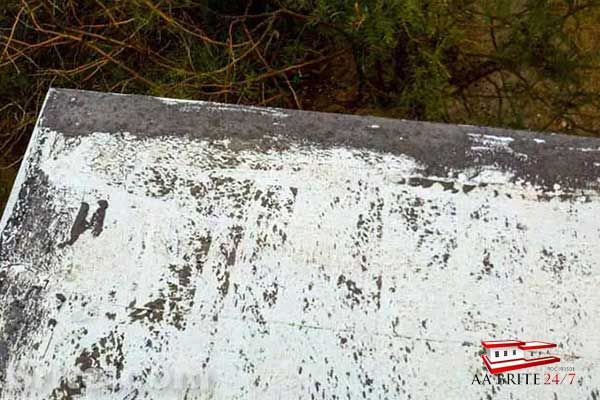Roof Adhesion Issues
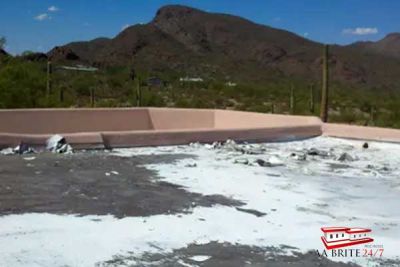
Greetings,
Robert Anderson, Principal Owner of AA Brite 24/7 here addressing some adhesion issues we’ve run into on elastomeric coated roofs in Tucson AZ. If your not in a desert climate, the principles discussed here are sound, but from what I’ve seen the materials and the way they age are significantly different than in other parts of the country.
We’ve been patching and re-coating elastomeric roofs professionally since 2003. For the most part, large scale adhesion issues are not all that common. The adhesion issues we see with elastomeric coatings the most are the result of a lack of an emulsifier – usually on a patched area.
Until recently almost 100% of the roofs with elastomeric (white or tan rubberized) coatings were applied on top of a tar paper and mopped on tar roof coating. (If your curious about this process then google Hot Mopped Roofing). Elastomeric roof coatings are not compatible with the oils on the surface of new tar or new tar paper.
If a roof was hot mopped with tar and coated without applying a significant amount of emulsifier first, the water based roof coating would fail. Sometimes it failed quickly and other times it would take a few years for the oils to migrate up and break the bond between the rubberized coating and tar.
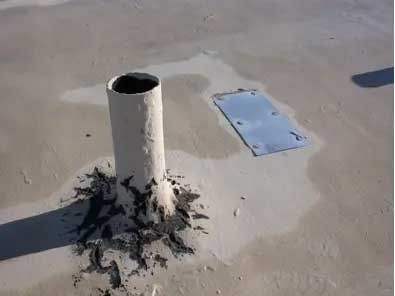

Adhesion issues between the cool coating / oily tar underneath it.
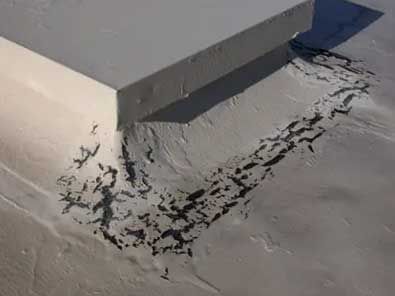

A tar patching compound was used here, and it was not sufficiently emulsified prior to applying elastomeric coating. The Elastomeric roof coating failed to adhere to the tar.
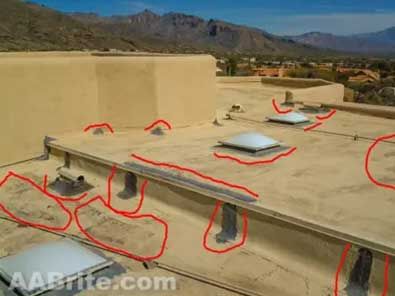

The elastomeric coating has flaked off and washed away as a result of a lack of emulsifier.
Emulsifier is a product that basically dries the oils on the surface of a tar product and allows a water based product to stick or adhere to the tar. Think of emulsifier as a primer that converts oil to something a water based paint wants to stick to.
We run into small emulsifier / adhesion issues pretty frequently – as shown in the above photos. Large scale adhesion issues based on emulsifier problems or misuse are fairly rare. Ironically the desert sun is helpful with this type of adhesion issue. The sun dries oils on a roof the same as it drys out our skin. Over a period of years the oil eventually evaporates off the surface and a once oily roof can be coated without using emulsifier or primer first. As it ages and becomes drier (less oily) the material goes from a rich black to a grey color.
Oil based tar on patched areas comprise 95% of the adhesion issues we see here in Arizona.
On rare occasions we run into other adhesion issues for elastomeric roof coatings.
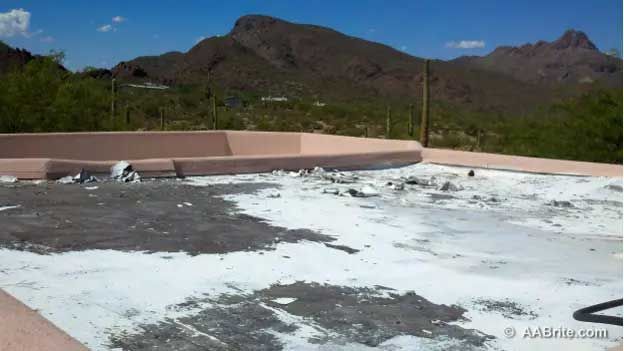
The roof in this photo was covered with some kind of rubber – similar to that in a bicycle inner tube. It’s my understanding this material is fairly common elsewhere, but in Arizona it pretty rare to see it on a home. It was then coated with an elastomeric – which didn’t stick to it.
This picture was taken in 2011 when I first saw the roof. At the time we were unaware of any primers or elastomeric roof coatings capable of adhering to it. We tried various primers and coatings in test areas and found one product that was marginally successful. It was basically a last resort and it held for about four years with a couple of areas needing touch ups. The alternative was to rip off the rubber and start over – which the client was against doing at the time.
Since then new products have been developed and we have had success using both Tucson Rubberized Primer 295 and Tucson Rubberized Emulsion 210. We do a test area first, let it cure for a week and then do a pull (adherence) test using a high strength tape. If its hard to pull off with high quality tape then the primer or emulsifier is sticking well. Prime or Emulsify and then coat with Elastomeric.
Side note here: If the entire roof is surrounded by a wall, even a short one as shown in the photo above, then the coating doesn’t HAVE to stick as well to the roof. If there is a wall on all four sides, then the wind usually can’t get under the coating and try to inflate it like a balloon. If the roof is not surrounded by walls, then typically the wind can blow into a patio or eve under the roof – and push straight up from below the coating. When this happens the grip strength of the coating is much more important.
Silicone Roof Coating
I only half jokingly tell homeowners I believe 100% silicon roof coatings should not be legal since it’s so difficult to patch them. At least it used to be. We’ve always refused to use 100% silicone coatings since they’ve been known as a one and done system. Coat and then you are done. Unfortunately if a patch was needed or a spot cracked out there were no readily known materials available to patch over them. (How do you patch a big scratch in a teflon pan? Throw it away).
In 2016 we ended up taking a roof patch and recoat job where the homeowner had used Silicon Roof Coating to patch three or four areas on his roof. We couldn’t find anything to stick to it – including more Silicon. Once Silicon cures, not much wants to stick to it. 10% silicon added to a regular elastomeric roof coating seems to be about the maximum before getting into future patching problems. We regularly use products containing up to 10% silicon.
In our limited experience with Silicon coatings since then we’ve found as they age in the Arizona sun the surface of the silicon becomes more receptive to getting other materials to adhere to it. We only have experience with about ten of these at this time, and doing a test patch and pull test is always the safest way to see if its something that can be patched.
In our case we are up front with the client about this, give them the phone numbers to two local roof supply companies and ask them to also do some research. We tell them if they can find someone with more experience who can guarantee their work we are fine not taking the job. We are basically patching them as a favor.
More recently – February of 2019 – we’ve tested a couple of new products from Henry’s that are labeled as being capable of patching silicon. I did a free job for a client who had silicon all around his roof mounted air conditioner. It was leaking. So far it’s held up to several rains. I didn’t charge him labor because I’m not confident the patch materials will hold up for years.
One spray can was $35 and one gallon of patch was $69.
If you are reading this and have solid answers and experience with patches on silicon coated roofs I’d love to talk to you or test your products.
More Roof Problems You May Have


